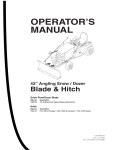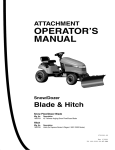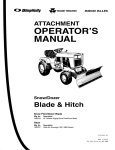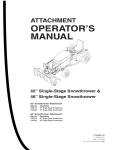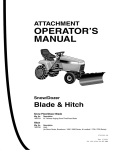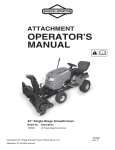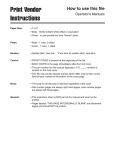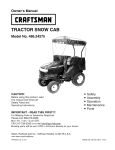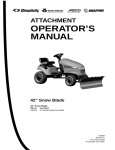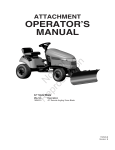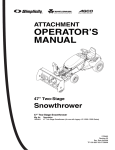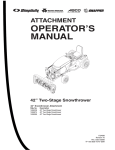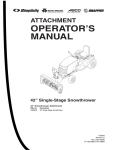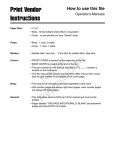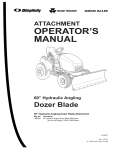Download Simplicity Snow Plow/Dozer Blade Operator`s manual
Transcript
Print Vendor Instructions Paper Size: How to use this file Operator’s Manuals • 11x17 • Body - 50 lbs brilliant white offset or equivalent • Cover - on pre-printed two tone “Swash” stock. Press: • Body - 1 color, 2-sided • Cover - 1 color, 1 sided Bindery: • Saddle stitch, face trim *if too thick for saddle stitch, tape bind Covers: • FRONT COVER is present at the beginning of the file. • BACK COVER is the page immediately after the front cover. • The part number for this manual (typically a 172_____ number) is located on the front cover. • This file may contain several manual which differ only by their covers. See the part number at the bottom of the cover page. . Body: • The body for all manuals is identical regardless of the cover. • Odd number pages are always right hand pages, even number pages are always left hand pages. General: • This instruction sheet is NOT part of the manual and must not be printed. • Pages labeled “THIS PAGE INTENSIONALLY BLANK” are placement pages and should NOT be printed. THIS PAGE INTENTIONALLY BLANK (FOR PLACEMENT ONLY - DO NOT PRINT) OPERATOR’S MANUAL 42” Angling Snow / Dozer Blade & Hitch Snow Plow/Dozer Blade Mfg. No. 1693754 Description 42” Angling Dozer Blade (Multiple Applications) Hitch Mfg. No. 1694147 Description Pivot Hitch (Prestige / 1800 / 2800 & Conquest / 1700 / 2700 Series) 1723445-02 Rev 11/2002 TP 100-2564-02-AT-SMA MANUFACTURING, INC. 500 N Spring Street / PO Box 997 Port Washington, WI 53074-0997 www.simplicitymfg.com © Copyright 2001 Simplicity Manufacturing, Inc. All Rights Reserved. Printed in USA. Table of Contents Adjustments.........................................................7 Skid Shoe Adjustment .....................................7 Spring Tension.................................................7 Lift Rod Adjustment .........................................8 Downward Pressure Adjustment .....................8 Recommended Accessories ..............................1 Safety Rules & Information General Warnings............................................2 Operating on Slopes........................................2 Preparation ......................................................2 Operating Safety..............................................2 Initial Setup & Assembly Dozer Components..........................................9 Assemble Blade.............................................10 Install Pivot Hitch ...........................................11 Install Dozer Blade ........................................11 Install Lift Rod................................................11 Install Angling Control Rod ............................12 Downward Pressure Lock..............................12 Features & Controls ............................................3 Blade Angle Control Lever...............................3 Hydraulic Attachment Lift Lever.......................3 Manual Attachment Lift Lever ..........................3 General Operating Instructions Checks Before Starting....................................4 Engine & Ground Speed Selection..................4 Transporting.....................................................4 Starting & Stopping .........................................4 Changing Angle of the Blade...........................5 Dozing Tips......................................................5 Snow Plowing Tips ..........................................5 Removing & Attaching the Hitch & Blade Removing & Attaching Dozer Blade ..............13 Lift Variations When Using Attachments Lift Variations When Using Attachments .......14 Hardware Identification & Torque Specifications Chart..............................................................16 Storage .................................................................5 Maintenance & Normal Care Schedule..............6 Schedule for Normal Care ...............................6 Lubricate the Dozer Blade ...............................6 NOTE: In these instructions, “left” and “right” are referred to as seen from the operating position. Recommended Accessories For best performance, it is recommended to use tire chains and two rear wheel weights. A rear-mounted weight box can also be added for additional traction. The maximum weight added to the tractor should not exceed 35 lbs. per wheel, plus 100 additional pounds in the rear weight box. For operation on slopes greater than 15% (8.5°), Quick Tach Weights, tire chains, and wheel weights are recommended. Never operate on slopes greater than 17.6% (10°). Required Accessories A Lift Lever Kit is required for some of the models covered by this manual, and must be installed as part of hitch installation. 1 Safety Rules & Information Read these safety rules and follow them closely. Failure to obey these rules could result in loss of control of unit, severe personal injury or death to you, or bystanders, or damage to property or equipment. The triangle in text signifies important cautions or warnings which must be followed. PREPARATION GENERAL WARNINGS ● Disengage the PTO before making any adjustments. ● Never attempt to make any adjustments while engine is running. ● Thoroughly inspect the area where the dozer is to be operated and remove all foreign objects. ● Adjust the skid shoe height to clear gravel or crushed stone surface. See the Adjustments section for procedure. ● Know the controls and how to stop quickly. READ THE TRACTOR OPERATOR’S MANUAL. ● Read this manual and the tractor Operator’s Manual carefully. Be thoroughly familiar with the controls and the proper use of the equipment. ● Never allow children to operate the machine. Do not allow adults to operate it without proper instruction. ● Do not carry passengers. ● Use only attachments or accessories designed for your machine. See your dealer for a complete list of recommended attachments or accessories. ● Keep the area of operation clear of all persons, particularly small children, and pets. ● Never direct discharge towards bystanders. ● Make sure all hardware is secure and that dozer blade is in good operating condition. ● Check to be sure all safety devices and shields are in place. ● Check that all adjustments are correct before using this unit. ● Gasoline is highly flammable. Follow all precautions listed in your tractor’s operator’s manual. ● Always wear eye protection while operating and performing adjustments to protect eyes from debris thrown by the dozer. ● When cleaning, repairing, or inspecting the unit make sure all moving parts have stopped. Disconnect and secure the spark plug wires and remove the key to prevent accidental starting. OPERATING SAFETY ● Always clear snow up and down the face of slopes, never across the face. Exercise extreme caution when changing direction on slopes. Do not attempt to clear steep slopes. ● Exercise extreme caution when operating on, or crossing, gravel drives, walks or roads. Stay alert for hidden hazards or traffic. ● After striking an object or if unit starts to vibrate abnormally, stop the engine and remove the key. Check for the cause and any damage before restarting. Before any inspection, make sure all moving parts have stopped. ● Take all possible precautions before leaving operator’s position. Lower the attachment, set the parking brake, stop the engine and remove the key. ● Never operate near glass enclosures, automobiles, window wells, dropoffs, etc. ● Do not put hands or feet near or under the dozer blade. Keep clear of the dozer blade at all times. ● Do not overload machine capacity by attempting to clear too much material at too fast a rate. ● Never operate unit at high transport speeds on slippery surfaces. Use care when travelling in reverse. ● Never operate the dozer blade without good visibility or light. Always be sure your feet are properly placed on the footrests and keep a firm hold on the steering wheel. ● Do not run the engine indoors. ● Never allow anyone in front of the unit. DANGER OPERATING ON SLOPES CAN BE DANGEROUS For operation on slopes greater than 15% (8.5°), weight box, tire chains, and wheel weights are recommended. NEVER OPERATE ON SLOPES GREATER THAN 17.6% (10°). 2 Features & Controls CONTROL FUNCTIONS B C A The information below briefly describes the function of individual controls. Operating the tractor and dozer require the combined use of these controls and additional controls whose operation is described in the tractor Operator’s Manual. Please take a moment and familiarize yourself with the name, location, and function of these controls so that you will better understand the safety and operating instructions provided in this manual. Figure 1. Control Locations A. Blade Angle Control Lever B. Hydraulic Lift Control C. Manual Lift Lever A. Blade Angle Control Lever The blade angle release lever controls a spring-loaded plate which locks the blade in one of three positions. Use an abrupt pushing/pulling motion to release the angling mechanism and move the blade left or right. Push the angling lever forward fully to lock the blade in the left position. Pull the lever fully back to lock the blade in the right position. Move the lever slowly past center to lock in the centered position. NOTE: It is easier to change the angle of the blade with the attachment raised. B. Hydraulic Attachment Lift Lever TRACTOR CONTROLS The hydraulic attachment lift lever raises and lowers the dozer blade. To RAISE an attachment, pull the lever back. To LOWER an attachment, push the lever forward. Before you begin operating the tractor with the dozer blade attachment, make certain you have: • Read and understood the instructions in the tractor Operator’s Manual. C. Manual Attachment Lift Lever • Become thoroughly familiar with all of the tractor controls and their operation, including how to safely and properly start and stop the unit. The manual attachment lift lever raises and lowers the dozer blade. To RAISE an attachment, depress the release button on top of the lever and pull back. To LOWER an attachment, depress the release button and move the lever all the way forward. Be sure to move the lever forward until it latches in the full forward position. • Practice driving in an open area—without dozing—to become accustomed to the unit. 3 General Operating Instructions Checks Before Starting WARNING 1. Refer to the Maintenance & Adjustments sections of this manual and perform any needed service. Also, refer to the tractor Operator’s Manual and perform any required service. Perform the Safety System Interlock test found in your tractor Operator’s Manual. If tractor does not pass the test, do not operate the tractor. See your authorized dealer. Under no circumstances should you attempt to defeat the safety system. 2. Remove any objects from the work area which might interfere with plowing activity. Use caution when plowing a snow covered area. Snow can cover objects such as curbs, drop-offs, and other obstacles. Be familiar with the area you are plowing. 3. Adjust the skid shoes to desired height. See Skid Shoe Adjustment. 4. Make sure all hardware is present and secure. To prevent an explosion or fire, never store the tractor with fuel in the tank inside a building where an ignition source is present. Engine & Ground Speed Selection Always run the engine at full throttle. Set tractor speed to obtain the needed power to move material. Operate at a safe speed, depending on conditions, so that you have complete control of the tractor. Rear wheel weights and chains are recommended for slippery surfaces. IMPORTANT NOTE To prevent damage to the unit, always raise the dozer blade BEFORE turning or backing up. A weight box is recommended for additional traction. DANGER Transporting OPERATING ON SLOPES CAN BE DANGEROUS For maximum ground clearance, transport the blade to and from work areas fully raised and angled straight ahead. Never operate on slopes greater than 17.6% (10°) which is a rise of 3-1/2 feet (106cm) vertically in 10 feet (607cm) horizontally. Starting & Stopping Operate the unit at a slow ground speed when driving onto slope. Avoid using brakes to control ground speed. 1. Start the tractor engine. Set engine throttle to full. When operating on slopes that are greater than 15 % (8.5°) but less than 17.6%, use additional wheel weights or counterweights. 2. Raise the attachment lift and travel to the work site. 3. Set the angling control to the desired angle. In addition to counterweights, use extra caution when operating on slopes. Drive UP and DOWN the slope, never across the face, use caution when changing directions and DO NOT START OR STOP ON SLOPE. 4. Lower the attachment lift and begin plowing. 5. Raise the plow before backing up. 6. To stop the tractor, set ground speed to neutral and set the parking brake. Before leaving the seat, stop the engine, set the parking brake, remove the key, and wait for all moving parts to stop. For additional traction, tire chains and a weight box can be added. Maximum weight added to tractor should not exceed 35 lbs. per wheel and 100 additional lbs. in weight box. 4 General Operating Instructions Changing Angle of the Blade: Snow Plowing Tips See Figure 1 for location of Controls. • Determine the best snow removal pattern before beginning. NOTE: It is easier to change the angle of the blade with the attachment raised. • Plan the pattern so that you avoid pushing snow onto cleared areas. 1. Raise the attachment lift. • When land contour permits, it is best to travel in long straight lines to minimize turning. 2. Use an abrupt pushing/pulling motion to release the angling mechanism and move the blade left or right. Push the angling lever forward fully to lock the blade in the left position. Pull the lever fully back to lock the blade in the right position. Move the lever slowly over center to lock in the centered position. • In very deep or heavy snow, it may be necessary to make the first pass with dozer blade partially raised, then repeat each pass with the blade lowered to clear the material left on the surface. Also, it may be necessary to clear less than the full width of the dozer blade or reduce ground speed. Dozing Tips • Snow tends to freeze into solid banks when plowed off a driveway or other large area. Because of this you may want to plow snow several feet past the edge of the drive to allow space for future plowing to build up. • Determine the best dozing pattern before beginning. • When land contour permits, it is best to travel in the longest direction to minimize turning. • In very deep snow or gravel, it may be necessary to make the first pass with dozer blade partially raised, then repeat each pass with the blade lowered to clear the material left on the surface. Also, it may be necessary to clear less than the full width of the dozer blade or reduce ground speed. • If pushing snow past the edges of driveways or sidewalks, be careful not to tear up the grass buried under snow next to the drive or sidewalk. Lift the blade several inches off the ground to avoid damaging the grass. • Spinning tires with tire chains can leave unsightly marks or permanent damage to asphalt or concrete driveways or sidewalks. Avoid sudden stops or starts. • When dozing, push the dirt to the desired location, then drag the blade backwards for final leveling. Pack down the dirt or gravel by driving the tractor over the leveled area. • Use any slight grade to your advantage, doze downhill, and set the blade angle so that the plowed material is moving downhill as it leaves the blade. Storage Off-Season Storage IMPORTANT NOTE 1. Remove dozer blade and hitch from the tractor. Refer to Tractor Operator’s Manual for important information concerning safely storing your tractor. 2. Use water pressure or a brush to thoroughly clean the dozer blade. 3. Paint, or lightly coat with oil, any area where paint has been worn or chipped away. Daily Storage 4. Lubricate the dozer blade. 1. Allow tractor engine to cool before storing in any enclosure. 5. Store the dozer blade and hitch in a dry place. 2. After dozing or plowing jobs are completed, hose or brush down the blade to remove excess dirt. 3. Lightly oil all pivot points. Coat bare metal surfaces to prevent corrosion. 5 Maintenance WARNING Lubricate Dozer Blade To avoid serious injury, perform maintenance on the tractor or dozer blade only when the engine is stopped, parking brake is set and all moving parts have stopped. Always remove the ignition key before beginning maintenance or adjustments to prevent accidental starting of the engine. Lubricate the dozer blade as shown in Figure 2. Where an oil can is shown, wipe the area clean, apply a few drops of oil (SAE 30), then wipe up drips or spills. In general, linkage connections and other parts that have partial rotational or sliding movement should be lubricated periodically with SAE 30 weight oil. Avoid applying excessive amounts of oil since this may cause a build-up of dirt around the lubricated area, making subsequent lubrication more difficult to accomplish. Schedule For Normal Care Care Required Schedule Clean debris from dozer blade. Lubricate dozer blade. After each use. Every 10 hours or at least once a year. Figure 2. Lubrication Points 6 Adjustments Skid Shoe Adjustment Slotted holes are provided to permit adjustment of the shoe assemblies for raising and lowering the blade to various working heights (see Figure 3). When cleaning snow from gravel or earth drives or walks, the shoe assemblies should be lowered fully to prevent blade contact with gravel or ground. When cleaning smooth hard surfaces like concrete, the shoe assemblies are normally placed fully up to allow the blade to scrape the surface. To adjust the skid, raise the blade off the ground and block with a piece of wood. Loosen the bolts (B, Figure 3) and move the skid shoes (A) up or down to desired height. Tighten the bolts securely. Figure 3. A. Skid Shoes B. Bolts Spring Tension See Figure 4. This snow plow/dozer blade is spring loaded so that when the blade strikes a solid object, the springs will allow the blade to release as shown, rather than cause damage. The blade will go back to its original position after object is cleared. Figure 4. Dozer Blade “Released” See Figure 5. To adjust spring tension hold rear nut (B) and loosen front nut (E). Tighten rear nut (B) to increase spring tension, or loosen to decrease tension. For initial adjustment, tighten nut (B) on each eyebolt enough to expose about 3/4" (19mm) of thread. Tighten front nut (E) against rear nut (B) to lock adjustment in place. Figure 5. Tension Springs A. Eyebolt B. Nut, 5/16 C. Spring 7 D. Pivot Frame E. Nut, 5/16 Adjustments Lift Rod Adjustment In the fully raised position the blade should be 4”-5” off the ground. In the fully lowered position, the lift rod should compress the spring creating downward pressure on the blade. D C B LIFT HEIGHT ADJUSTMENT A 1. Fully raise the attachment lift. The attachment should be approximately 4”-5” off the ground. If not, go to step 2. 2. Lower the attachment and adjust the front set collar (A, Figure 6) to achieve the correct lift height. E DOWNWARD PRESSURE ADJUSTMENT 1. Place the lift in the fully raised position. Figure 6. Adjusting Lift Rod A. Front Set Collar B. Rod Guide C. Spring D. Rear Set Collar E. Spring Clip 2. Slide the spring (C, Figure 6) forward so it is against the front set collar (A). Slide the rear set collar (D) up against the back of the spring. Use the rear set collar to compress the spring slightly, then tighten the set screw. IMPORTANT NOTE DO NOT OVER-COMPRESS THE SPRING. In addition to providing downward pressure, the spring is an elastic medium that absorbs shocks caused by bumps and cracks in ground surfaces. Over-compressing the spring defeats this and may cause damage to the unit. 8 Initial Setup & Assembly Pivot Hitch 30 1 31 4 5 4 6 38 3 32 4 2 4 33 3 7 8 9 10 29 28 35 11 12 37 34 36 27 2 26 25 22 24 23 10 21 20 17 18 19 15 13 14 Ref Qty Description 1 1 ROD, Control Handle, Upper 2 6 NUT, Hex, 5/16-18 3 2 LOCKWASHER, 5/16 4 4 WASHER, 5/16 5 2 CAPSCREW, 5/16-18 x 1-1/4 6 1 ROD, Control Handle, Lower 7 1 CLEVIS 8 1 WASHER, 1/2 9 1 CLIP, Hair Pin 10 3 COTTER PIN 11 1 ROD & PLATE ASMY, Pivot 12 1 DOZER BLADE ASMY, 42” 13 1 SCRAPER BAR 15 16 Ref Qty Description 14 6 CARRIAGE BOLT, 3/8-16 x 1 15 10 LOCKWASHER, 3/8 16 6 NUT, Hex, 3/8-16 17 2 SKID SHOE 18 4 WASHER, Plain, 3/8 19 4 CAPSCREW, 3/8-16 x 3/4 20 2 CAPSCREW, 1/2-13 x 1-1/2 21 2 SPACER, 1/2 x 3/4 x 5/16 22 1 ROD, Latch Stop 23 2 LOCKNUT, 1/2-13 24 1 FRAME ASMY, Dozer 25 2 EYEBOLT 26 2 SPRING, Extension Figure 7. Dozer Blade and Pivot Hitch 9 Ref Qty Description 27 1 CLIP, Hair Pin 28 1 PLATE ASMY, Latch 29 2 SPRING, Torsion 30 1 EYEBOLT 31 1 NUT, 1/4-20 32 1 SUPPORT, Control Rod 33 2 NUT, 5/16-18 34 2 WASHER, 5/16 35 2 CAPSCREW, 5/16-18 x 1 36 1 HAIR PIN CLIP 37 1 PIVOT PIN 38 1 PIVOT HITCH Initial Setup & Assembly A D B Figure 8. Tension Springs A. Eyebolt B. Nut, 5/16 C. Spring C Figure 9. Install pivot hitch Assembly A. Safety Clip C. Long Hitch Pin B. Pivot Hitch D. Sub-Frame Hitch D. Pivot Frame E. Nut, 5/16 INITIAL SETUP & ASSEMBLY C Assemble Blade 1. See Figure 8. Insert threaded end of eyebolt (A) through lug on blade, and screw on 5/16 nut (B) just far enough so that it is flush with the end of the eyebolt. 2. See Figure 8. Hook the springs (C) into the pivot frame (D). Using a pliers, stretch the springs to hook the opposite ends to the eyebolts (A). 3. See Figure 8. Tighten the nut (B) on each eyebolt enough to expose about 3/4" (19 mm) of thread. 4. See Figure 8. Holding the first nut (B) with a wrench,add a second nut (E) to each eyebolt, and tighten securely against the first nut to act as a jam nut. B D A Figure 10. Dozer Blade Assembled and Installed A. Pivot Hitch C. Pivot Pin B. Pivot Frame D. Spring Clip Install Pivot Hitch 1. Position the pivot hitch (B, Figure 9) under the front of the sub-frame hitch (D). 2. Secure the pivot hitch (B) to the front set of holes in the sub-frame hitch (D) and secure using the long hitch pin (C, included with the sub-frame hitch) and safety clip (A). Install Dozer Blade 1. Insert the front of the pivot hitch (A, Figure 10) into pivot frame (B) on rear of blade. Then install pivot pin (C) down thru front holes in blade and push bar. Secure the pivot pin (C) with a spring clip (D). 10 Initial Setup & Assembly Install Lift Rod 1. Insert the end of the rod guide (A, Figure 11) through hole in upright of lift arm (B), and secure with spring clip (C). C B NOTE: The rod guide (A, Figure 11) should be installed in the lower hole for hydraulic lift applications. For manual lift applications, the rod guide may be installed in either hole. The upper hole provides reduced lift effort; the lower hole provides increased lift height. A Figure 11. Lift Rod Assembly A. Rod Guide B. Push Bar Lift Arm C. Spring Clip 2. Connect the rear of the lift lever (A, Figure 12) to the lift arm extension (B) using a hair pin clip (C). 3. Adjust lift rod. Different types of terrain may require an adjustment to the lift rod assembly. For instructions on how to make this adjustment refer to the “Lift Rod Adjustment” procedure in the ADJUSTMENTS section of this manual. B C Figure 12. Install Lift Rod A. Lift Rod B. Lift Arm Extension C. Hair Pin Clip 11 A Initial Setup & Assembly Install Angling Control Rod NOTE: If installing dozer blade on the unit equipped with a snowcab, the angling rod support (A, Figure 14) is not required. F B A 1. Remove the front two ratchet fasteners from the right foot rest pad. Peel the foot rest pad back. E 2. Remove and discard the taptite screw (F). 3. Mount the angling control rod support (A) to the bottom of the frame foot rest support (D). Secure using two 1/16-18 x 1 capscrews, washers, and nuts (C). D NOTE: The inside hole used with the inside capscrew (B) can be accessed through the gap between the foot rest (E) and dashboard in front of the brake pedal. C 4. Reinstall the foot rest pad. Figure 13. Control Rod Support A. Support B. Capscrew, 5/16-18 x 1 C. Washer & Nut D. Footrest Support (Frame) E. Foot Rest (Tunnel) F. Original Taptite Screw (Discard) 3. Connect the lower angling rod (F, Figure 15) to the dozer release lever using a hair pin clip and washer (G). D C 4. Insert the upper control rod (C) through the eyelet (B), and secure the eyelet to the support using a 1/420 nylock nut (A). B E NOTE: It may be necessary to leave the eyelet nut (A, Figure 24) loose to prevent binding. F 5 Secure the upper rod (C) to the lower rod (F) using two 5/16-18 x 1-1/4 capscrews (D), washers (qty. 4), lockwashers, and nuts (E). NOTE: Match offset to offset so the rods form a straight line. G Downward Pressure Lock Install the down-pressure lock plate (hydraulic lift models) or switch the lift bar from mowing position to dozer position. See page 14. Figure 14. Assemble Control Rods A. 1/4-20 Nylock Nut B. Eyelet C. Upper Control Rod D. 5/16-18 x 1-1/4 Capscrew E. 5/16 Washers, Lockwashers, & Nuts F. Lower Control Rod G. Hair Pin Clip & Washer 12 A Removing & Attaching the Hitch & Blade A B B C D E B Figure 15. Dozer Removal A. Support Arm C. Pivot Pin B. Hair Pin Clip D. Hair Pin Clip & Washer E E. Hitch Pin & Safety Clip F. Pivot Hitch REMOVAL & INSTALLATION Removing & Attaching Dozer Blade 5. Lower the lift and remove the clip (B) securing the lift rod to the push bar and lift rod. 1. Lower the blade. Position the lift so that it is not lifting the blade or applying downward pressure. 6. Remove the hitch pin and safety clip (E) securing the pivot hitch (F) to the sub-frame hitch. Remove the pivot hitch. 2. Remove the hair pin clip and washer (D, Figure 16) securing the angling control rod to the clevis. Disconnect the angling control rod. 7. Remove the sub-frame hitch (refer to sub-frame hitch instructions. 3. Remove the angling control rod from the support arm (A). 4. Remove the pivot pin (C) connecting the blade and pivot hitch. Remove the blade. 8. Reinstall all pins for storage. Install in reverse order of removal. 13 Lift Variations Snowthrower & Dozer Applications Snowthrower & Dozer Applications E A A B F C D E C B D Mower Applications Mower Applications G A A B F G F E Figure 16. Lift Lock Plate - Hydraulic Lift Models A. Lift Cylinder B. Flat Head Pin (Original) C. Flat Head Pin (New) D. Lock Plate E. Hair Pin Clips F. Lift Shaft Assy. G. Washers C D Figure 17. Lift Link - Manual Lift Models A. Pin B. Rear Hole of Lift Bar (Snowthrower Applications) C. Spacer D. Hair Pin Clip E. Upper Hole (Snowthrower Applications) F. Slot of Lift Link (Mower Applications) G. Lower Hole (Mower Applications) LIFT VARIATIONS WHEN USING ATTACHMENTS When a front-mounted attachment such as a snowthrower or dozer blade is used with the tractor, the lift mechanism must be locked to provide downward force. When the mower is reinstalled the downward pressure lock must be released so that the mower can float. Hydraulic Lift Models Manual Lift Models When using a snowthrower or dozer, the downward pressure lock plate (D, Figure 16) and an additional pin (C) is installed. These parts are included with the attachment. Note that the washers (G) are not used with the lock plate. NOTE: These instructions apply to Conquest / 1700 / 2700 Series tractors or Broadmoor / 1600 / 2600 Series tractors equipped with a lift lever kit. The lift link is installed differently depending on what attachment is being used. Refer to Figure 17 for link installation information. When mowing, the downward pressure lock plate (D) is removed and replaced with two washers (G). The additional pin (C) is also removed. Fully lower the hydraulic lift. The lift assembly is spring loaded so it will need to be held in the down position to perform of the following procedures. 14 Notes 15 Hardware Identification & Torque Specifications Common Hardware Types Torque Specification Chart Hex Head Capscrew FOR STANDARD MACHINE HARDWARE (Tolerance ± 20%) Washer Hardware Grade Lockwasher Carriage Bolt No Marks SAE Grade 2 Hex Nut Size Of Hardware Standard Hardware Sizing 8-32 8-36 10-24 10-32 1/4-20 1/4-28 5/16-18 5/16-24 3/8-16 3/8-24 7/16-14 7/16-20 1/2-13 1/2-20 9/16-12 9/16-18 5/8-11 5/8-18 3/4-10 3/4-16 7/8-9 7/8-14 1-8 1-12 When a washer or nut is identified as 1/2”, this is the Nominal size, meaning the inside diameter is 1/2 inch; if a second number is present it represent the threads per inch When bolt or capscrew is identified as 1/2 - 16 x 2”, this means the Nominal size, or body diameter is 1/2 inch; the second number represents the threads per inch (16 in this example, and the final number is the body length of the bolt or screw (in this example 2 inches long). The guides and ruler furnished below are designed to help you select the appropriate hardware and tools. 0 1/4 Nut, 1/2” 1/2 Inside Diameter 3/4 1 1/4 1/2 3/4 Screw, 1/2 x 2 2 1/4 Body Diameter in/lbs ft/lbs 19 20 27 31 66 76 11 12 20 23 30 35 50 55 65 75 90 100 160 180 140 155 220 240 Nm. 2.1 2.3 3.1 3.5 7.6 8.6 15.0 16.3 27.2 31.3 40.8 47.6 68.0 74.8 88.4 102.0 122.4 136 217.6 244.8 190.4 210.8 299.2 326.4 SAE Grade 5 in/lbs ft/lbs 30 31 43 49 8 10 17 19 30 35 50 55 75 90 110 120 150 180 260 300 400 440 580 640 SAE Grade 8 Nm. in/lbs ft/lbs Nm. 3.4 3.5 4.9 5.5 10.9 13.6 23.1 25.8 40.8 47.6 68.0 74.8 102.0 122.4 149.6 163.2 204.0 244.8 353.6 408.0 544.0 598.4 788.8 870.4 41 43 60 68 12 14 25 27 45 50 70 80 110 120 150 170 220 240 386 420 600 660 900 1,000 4.6 4.9 6.8 7.7 16.3 19.0 34.0 34.0 61.2 68.0 95.2 108.8 149.6 163.2 204.0 231.2 299.2 326.4 525.0 571.2 816.0 897.6 1,244.0 1,360.0 NOTES 1. These torque values are to be used for all hardware excluding: locknuts, self-tapping screws, thread forming screws, sheet metal screws and socket head setscrews. 2. Recommended seating torque values for locknuts: a. for prevailing torque locknuts - use 65% of grade 5 torques. b. for flange whizlock nuts and screws - use 135% of grade 5 torques. 3. Unless otherwise noted on assembly drawings, all torque values must meet this specification. 1/2 Body Length 3/4 3 1/4 1/2 3/4 4 Wrench & Fastener Size Guide 1/4 5/16 3/8 1/4” Bolt or Nut Wrench—7/16” 5/16” Bolt or Nut Wrench—1/2” 3/8” Bolt or Nut Wrench—9/16” 7/16 DIA. 7/16” Bolt or Nut Wrench (Bolt)—5/8” Wrench (Nut)—11/16” 1/2 DIA. 1/2” Bolt or Nut Wrench—3/4”




















